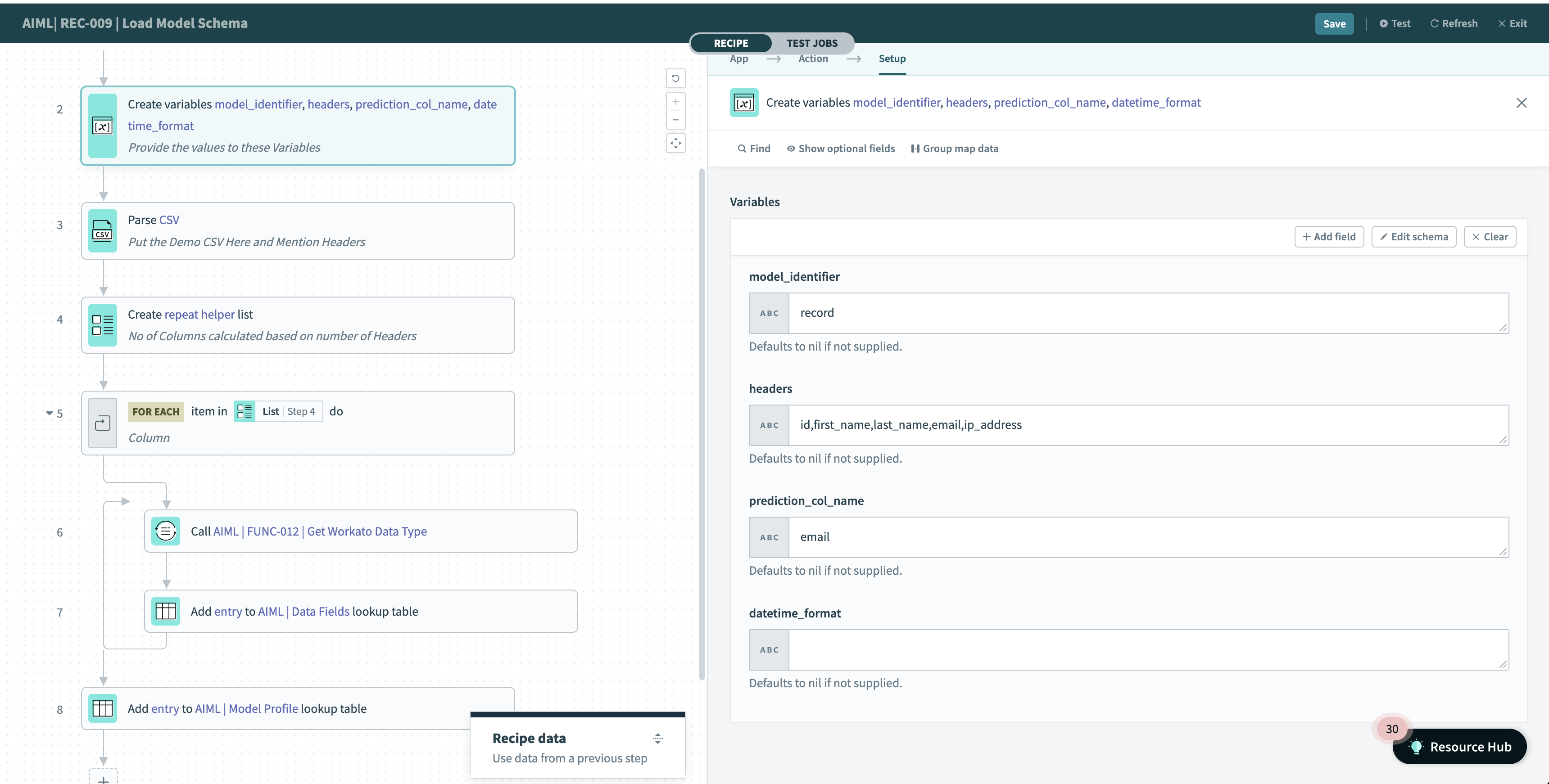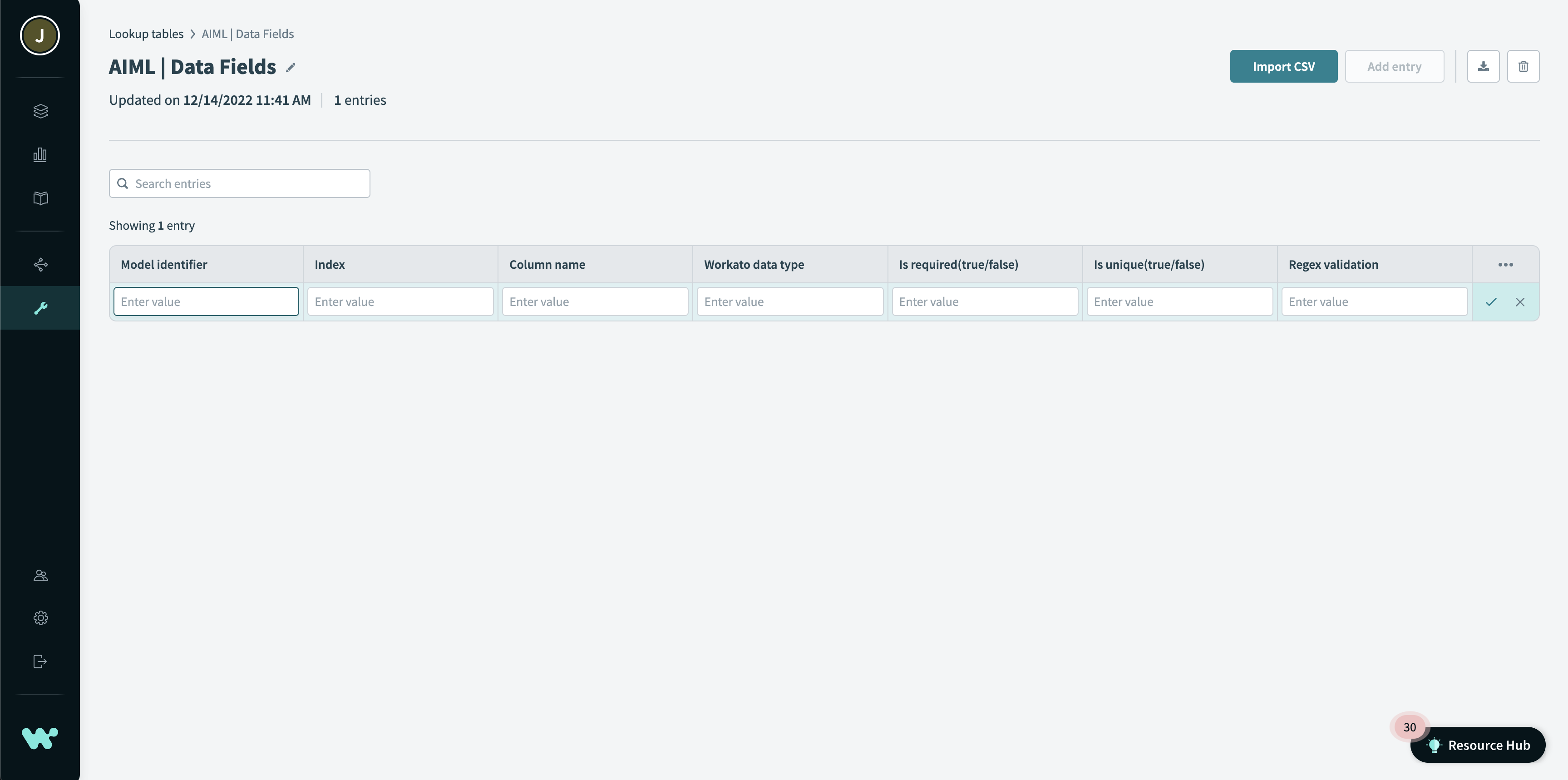# Start the AIML accelerator
# Start the recipes
Navigate to Projects > Home > AIML Accelerator.
Start all of the recipes in the following folders in this order:
- API endpoints
- AWS S3
- AWS Sagemaker
- Functions
# Load your schema
The AIML|Data Fields lookup table saves the schema of the data model deployed on SageMaker. Workato sends data to Sagemaker to create and train a data model. Sagemaker then validates this data against the rules defined in the AIML | Data Fields lookup table.
 Data fields lookup table
Data fields lookup table
There are two options to configure the AIML | Data Fields lookup table. The first option is to click Add Entry and manually configure each data field. The second option is to use the AIML|REC-009|Load Model Schema recipe to automate this process. This recipe also adds an entry to the AIML | Model Profile lookup table.
Follow these steps to use the AIML | REC-009 | Load Model Schema recipe:
In Workato, Navigate to Projects > Home > AIML Accelerator > Bootstrap.
Select AIML | REC-009 | Load Model Schema.
Configure the input fields in Step 2.
 Configure input fields
Configure input fields
- model_Identifier
- Provide a unique, user-friendly name to identify the machine learning model.
- headers
- Provide the column names of the schema in CSV format without any spaces.
- prediction_col_name
- Provide the name of the prediction column.
- datetime_format
- If the data contains date-time values, provide the format to enable Workato to parse them. See date-time formats for a list of formats Workato supports.
In Step 3, provide sample CSV data for the data model to consume.
Example:
id,first_name,last_name,email,ip_address
1,Lucy,Carrigan,lcarrigan@example.com,123.45.678.900
2,Jude,Feeney,jfeeney@example.com,987.65.43.210.012
3,Sadie,Simmons,ssimmons@example.com,345.67.890.100
Click Test to run the recipe one time.
Navigate to the AIML|Data Fields lookup table to check for the updated values.
Manually provide the validation rules by configuring the input fields.

- Workato data type
- Provide the data type of the field. See Workato-supported data types for a list of data types Workato supports.
- Is required (true/false)
- Set to true if the field is a required field. Set to false or leave blank if the field is not required.
- Is unique (true/false)
- Set to true if the field's value must be unique within the dataset used to train the model. Set to false or leave black if the value must not be unique.
- Regex pattern
- Workato checks data against this pattern.
# Define model profile
The AIML|Model Profile lookup table stores the model profile of the machine learning model used by the solution. The recipes use these profiles to read the data and connect to the machine learning platform.
Follow these steps to define your model profile. If you used the AIML|REC-009|Load Model Schema recipe, you can skip to Step 3:
In Workato, navigate to Tools > Lookup tables and select the AIML|Model Profile lookup table from the available list of lookup tables.
Add an entry to the lookup table and provide a Model Identifier for the model. This Model Identifier must match the Model Identifier you provided in the AIML|Data Fields lookup table.
Provide an AIML | Connection Profile in JSON format. Workato requires these parameters to connect with the machine learning model.
We have configured the following example for Sagemaker:
{
"endpoint_name":"{Unique Endpoint_name}",
"role_arn":"arn:aws:iam::xxxx:role/service-role/AmazonSageMaker-xxxxRole-xxxx"
}
Provide a Storage Source Connection Profile in JSON format. Workato requires these parameters to connect with the source data storage location.
We have configured the following example for AWS S3:
{
"accelerate": "false",
"region": "xx-xxx-x",
"bucket": "xxxx",
"object_name": "xxxxx_training_data.csv"
}
Provide a Storage Target Connection Profile in JSON format. This is where Workato moves the target data after validation and passes it to SageMaker. Workato requires these parameters to connect with the storage location.
We have configured the following example for AWS S3:
{
"accelerate": "false",
"region": "xx-xxx-x",
"bucket": "xxxx",
"object_name": "xxxxx_training_data.csv"
}
Provide the Number of ML Models. This number defines the number of models the machine learning model creates.
NUMBER OF ML MODELS
A higher number of ML models correlates to more computational resources and longer job time. A higher number also generally results in superior machine learning models.
Last updated: 12/28/2022, 5:28:45 AM